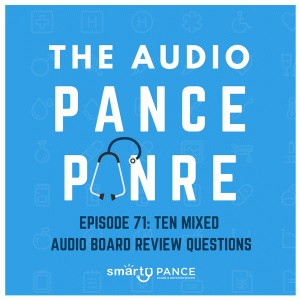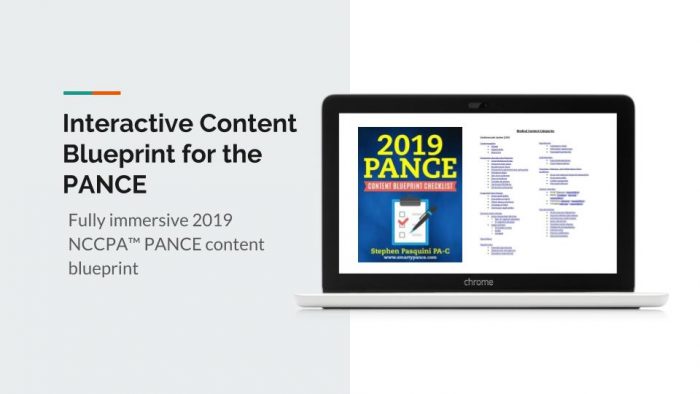The Audio PANCE and PANRE Physician Assistant Board Review Podcast

Welcome to episode 71 of the Audio PANCE and PANRE PA Board Review Podcast.
Join me as I cover ten PANCE and PANRE Board review questions from the SMARTYPANCE course content following the NCCPA content blueprint (download the FREE cheat sheet).
content blueprint (download the FREE cheat sheet).
This week we will be covering ten general board review questions based on the NCCPA PANCE and PANRE Content Blueprints.
Below you will find an interactive exam to complement the podcast.
I hope you enjoy this free audio component to the examination portion of this site. The full board review includes over 2,000 interactive board review questions and is available to all members of the PANCE and PANRE Academy and Smarty PANCE.
- You can download and listen to past FREE episodes here, on iTunes, on Google Play Music or Stitcher Radio.
- You can listen to the latest episode, take an interactive quiz and download your results below.
Listen Carefully Then Take The Practice Exam
If you can’t see the audio player click here to listen to the full episode.
Podcast Episode 71: Ten Question PANCE and PANRE Podcast Quiz
The following questions are linked to NCCPA Content Blueprint lessons from the Smarty PANCE and PANRE Board Review Website. If you are a member you will be able to log in and view this interactive video lesson.
1. A 52-year-old male presents complaining of urinary frequency, with hesitancy, and nocturia for the past few months. During his physical examination, you note a nontender, non-enlarged prostate with an isolated right posterior lobe nodule. Which of the following options is most appropriate?
- order a serum acid phosphatase level
- initiate prazosin and schedule a follow-up appointment in 6 weeks
- refer the patient for an ultrasound of the prostate and order a PSA level
- reassure the patient and schedule a follow-up appointment in six months
- initiate norfloxacin therapy for seven days and schedule follow-up in two weeks
2. Which of the following is a major contraindication to curative surgical resection of a lung tumor?
A. Liver metastases
B. Vagus nerve involvement
C. Non-malignant pleural effusion
D. Chest wall invasion of the tumor
3. A 23-year-old female complains of fever and genital pain. Examination reveals the presence of lymphadenopathy in the groin and the presence of vulvar vesicles surrounded by erythematous skin. The diagnosis may be confirmed by
A. A culture of a vesicle using blood agar medium
B. The presence of similar lesions on the fingers and hands
C. A Gram stain of a scraping from the base of the lesion
D. The presence of giant multinucleated cells on Tzanck smear
4. A 28-year-old woman is complaining of heavy uterine bleeding and pelvic pressure that has progressively worsened over the past year. Evaluation reveals multiple moderate-sized uterine fibroids. The patient desires to have more children. The most appropriate definitive treatment is
A. Myomectomy
B. Hysterectomy
C. GnRH agonists
D. Oral progesterone
5. A 59-year-old otherwise healthy female develops acute dyspnea and chest pain one week post total abdominal hysterectomy. Echocardiogram demonstrates normal heart size with normal right and left ventricular function. Lung scan demonstrates two segmental perfusion defects. Which of the following is the next step in the management of this patient?
A. Anticoagulation
B. Embolectomy
C. Thrombolysis
D. Inferior vena cava filter
6. Long term use of which of the following drugs may cause a drug-induced lupus-type eruption?
A. prednisone
B. tetracycline
C. procainamide
D. oral contraceptives
7. Which of the following clinical manifestations is most commonly seen in viral croup?
A. drooling
B. wheezing
C. sputum production
D. inspiratory stridor
8. Whispered voice test on a patient reveals decreased hearing in the left ear. Which of the following would be most consistent with conductive hearing loss in the left ear?
A. Sounds best heard in the left ear on Weber test.
B. Air conduction longer than bone conduction in the left ear on Rinne test.
C. Sound best heard in the right ear on Weber test.
D. Bone conduction longer than air conduction in the right ear.
9. A 65-year-old male presents with multiple lesions on his back. He denies any pruritis. Physical examination reveals the presence of multiple scattered brown plaques with a raised, warty surface that appears to be stuck onto the skin and feel greasy. Which of the following is the most likely diagnosis?
A. lentigines
B. actinic keratosis
C. keratoacanthomas
D. seborrheic keratosis
10. You are called to the nursery to see a male infant, born by uncomplicated vaginal delivery. He weighs 2,600 grams and has one deep crease on the anterior third of each foot. Respirations are 88 breaths/minute with expiratory grunting and intercostals retractions. He is cyanotic on room air and becomes pink when placed on 60% oxygen. Chest x-ray shows atelectasis with air bronchograms. Which of the following is the most likely diagnosis?
A. neonatal pneumonia
B. congenital heart disease
C. hyaline membrane disease
D. chronic lung disease of prematurity
Looking for all the podcast episodes?
This FREE series is limited to every other episode, you can download and enjoy the complete audio series by joining The PANCE and PANRE Exam Academy + SMARTYPANCE
I will be releasing new episodes every few weeks. The Academy is discounted, so sign up now.
Resources and Links From The Show
- My list of recommended PANCE and PANRE review books
- Interactive PANCE and PANRE NCCPA Exam Content Blueprints
- Sign up for the FREE daily PANCE and PANRE email series
- Join the Smarty PANCE NCCPA Content Blueprint Website + The PA Life Academy
- Get 20% of any Picmonic membership by using this link
- Use Code “PALIFE” and get 10% OFF THE RUTGERS PANCE AND PANRE REVIEW COURSE
This Podcast is also available on iTunes and Stitcher Radio for Android
- iTunes: The Audio PANCE AND PANRE Podcast iTunes
- Stitcher Radio: The Audio PANCE and PANRE Podcast Stitcher

Download The Content Blueprint Checklist
Follow this link to download your FREE copy of the Content Blueprint Checklist
Print it up and start crossing out the topics you understand, marking the ones you don’t and making notes of key terms you should remember. The PDF version is interactive and linked directly to the individual lessons on SMARTY PANCE.
Download for PANCE Download for PANRE
The post Podcast Episode 71: Ten PANCE and PANRE Audio Board Review Questions appeared first on The Audio PANCE and PANRE.


